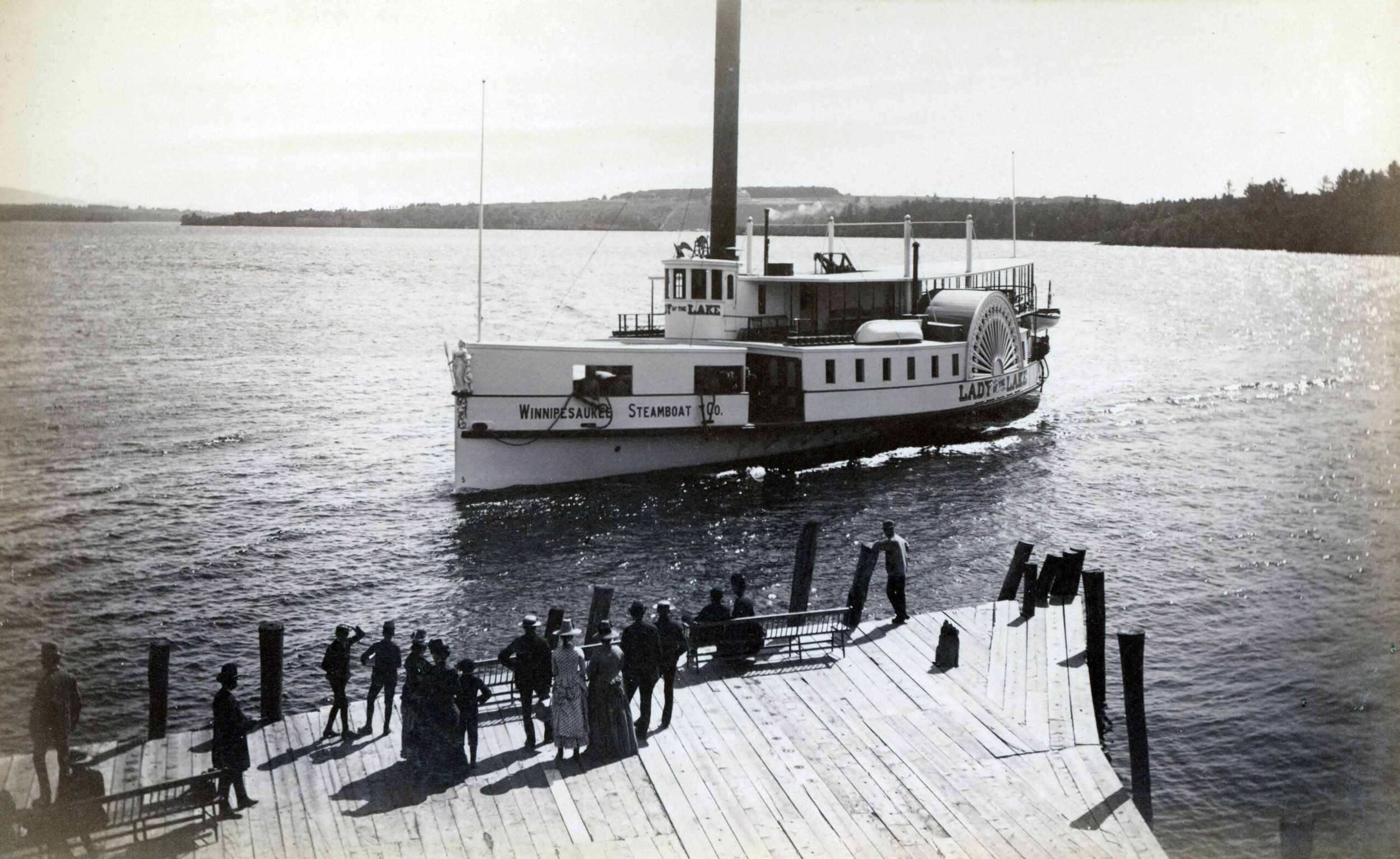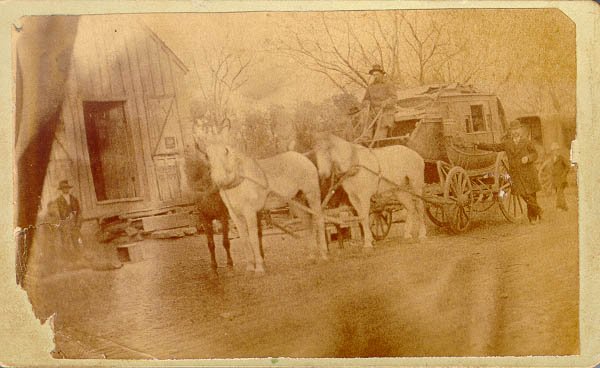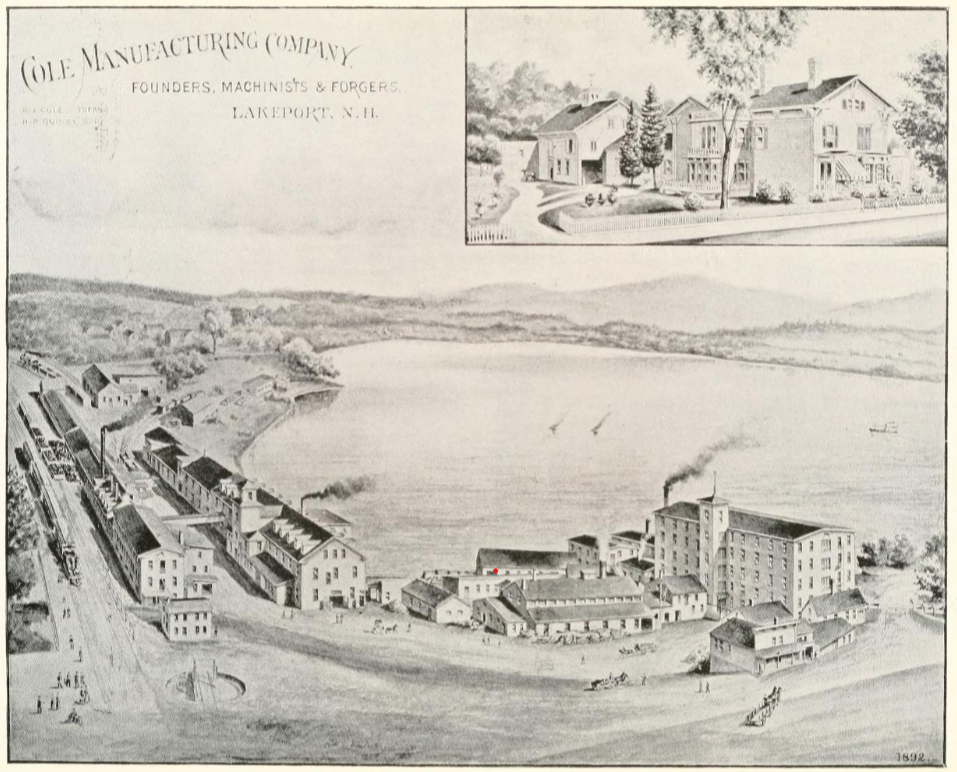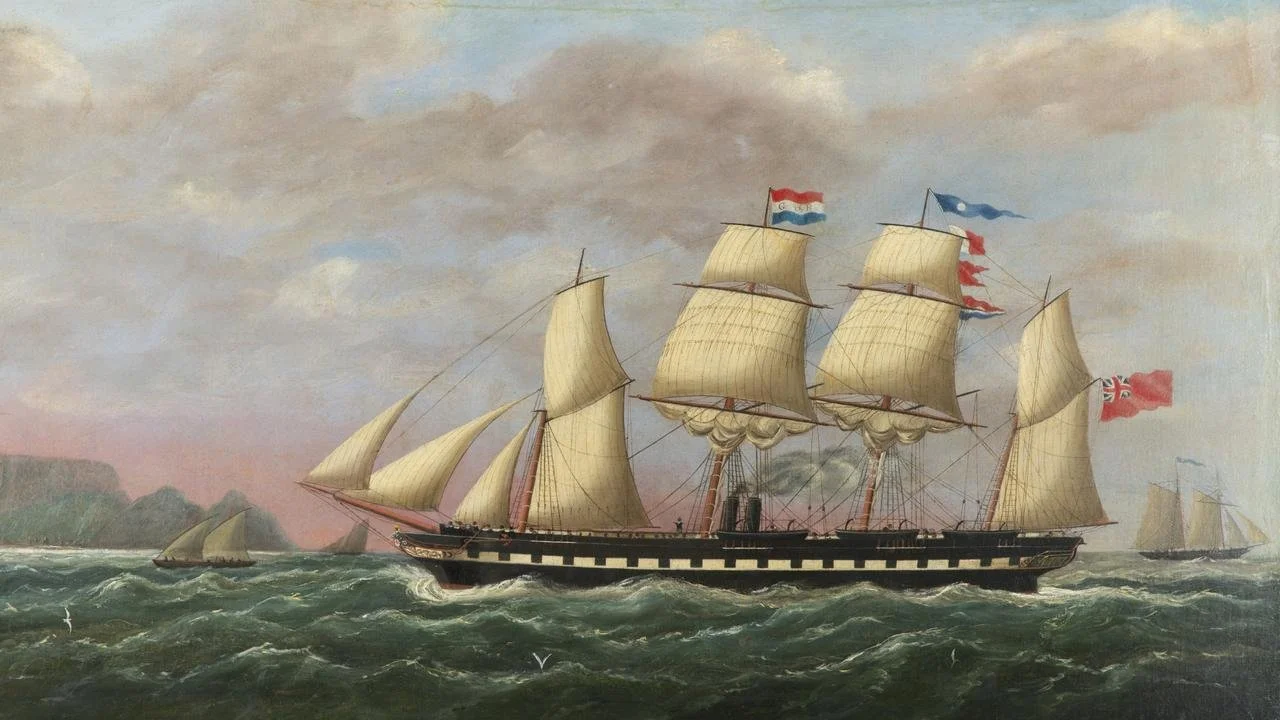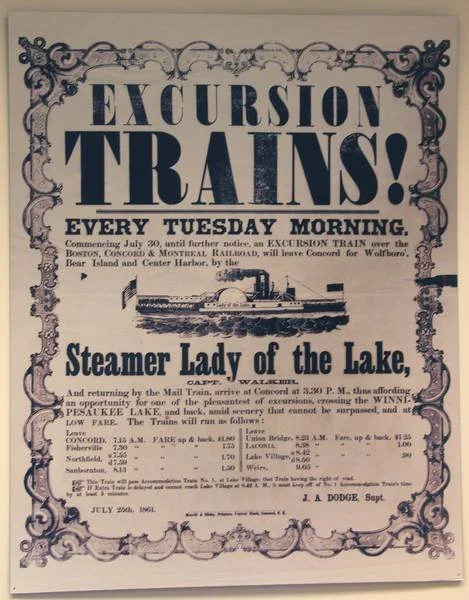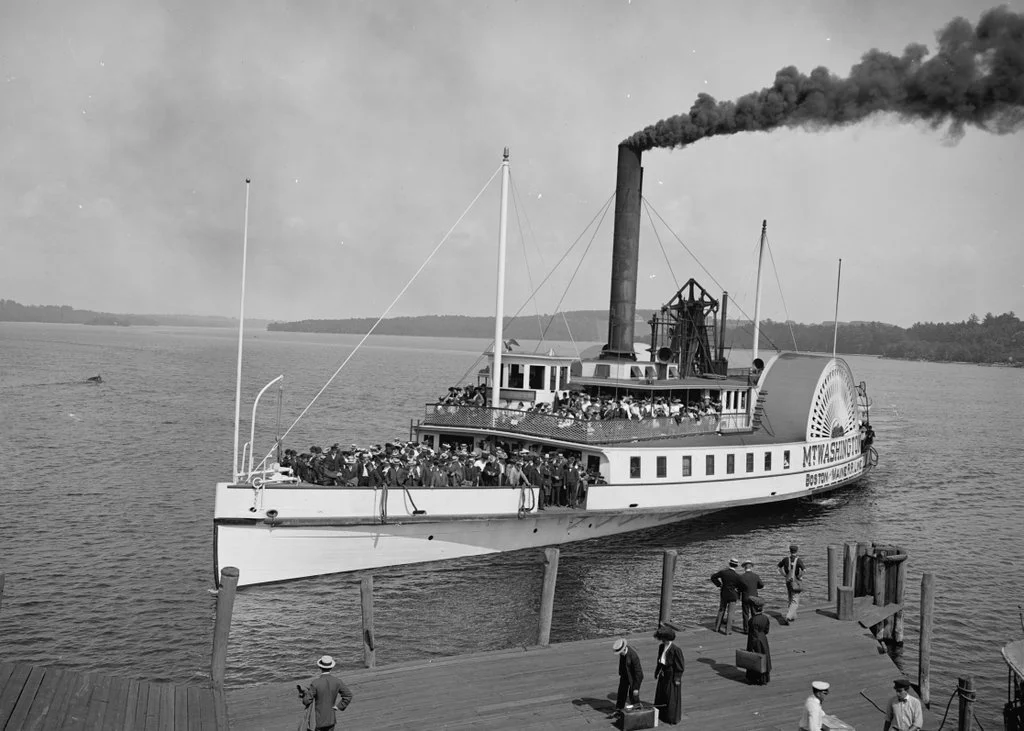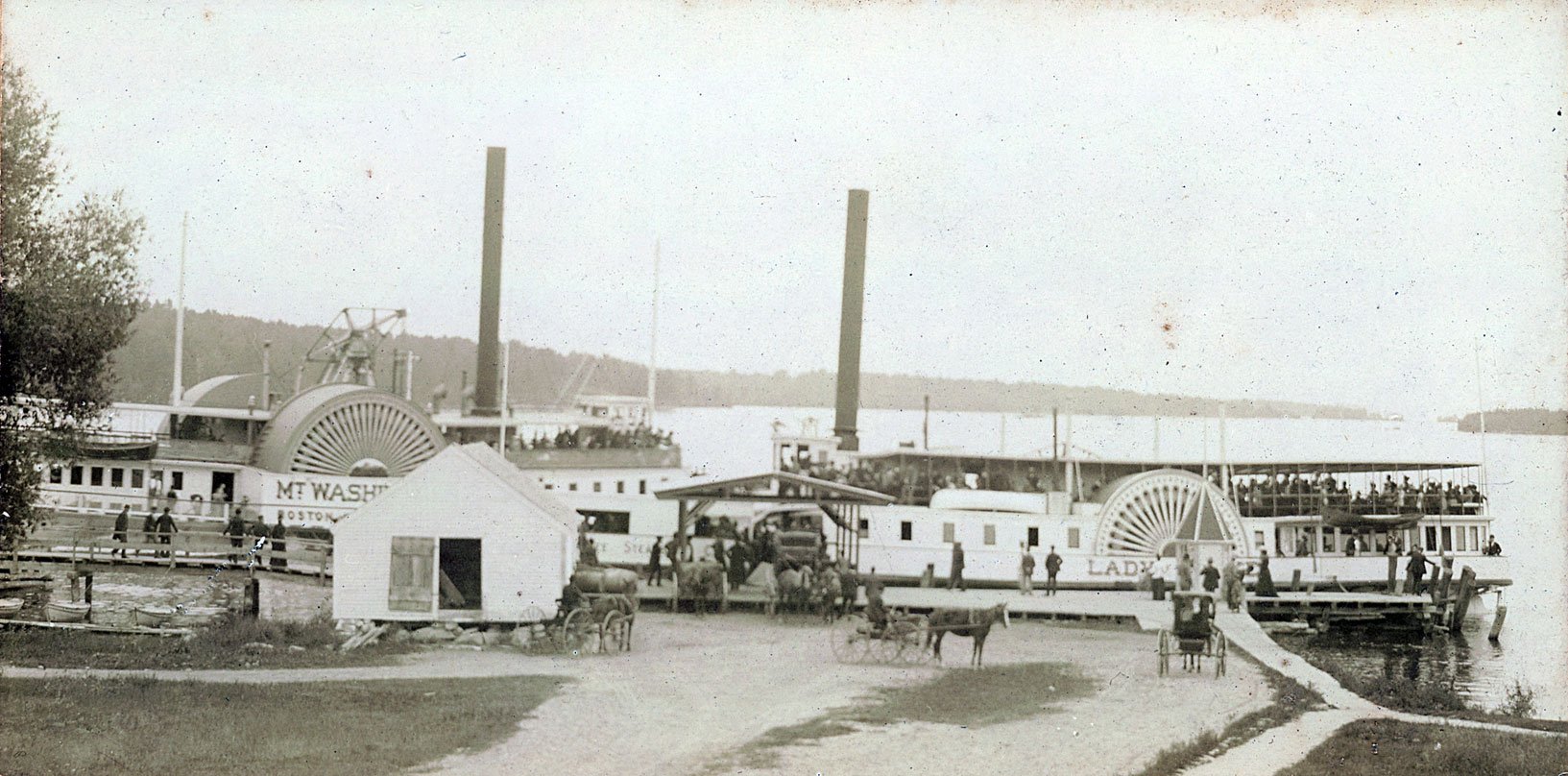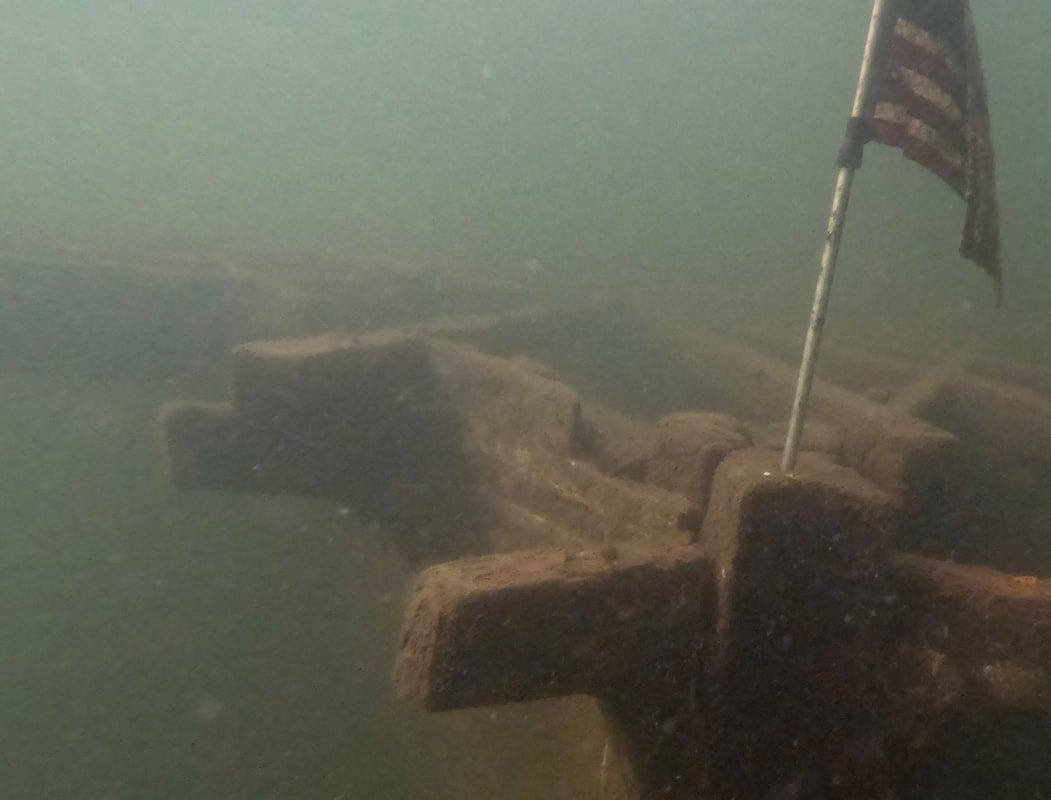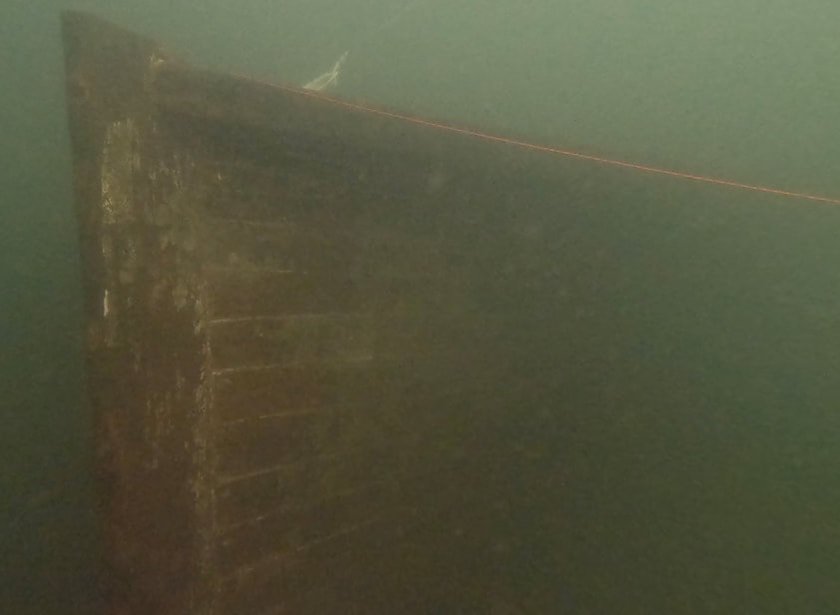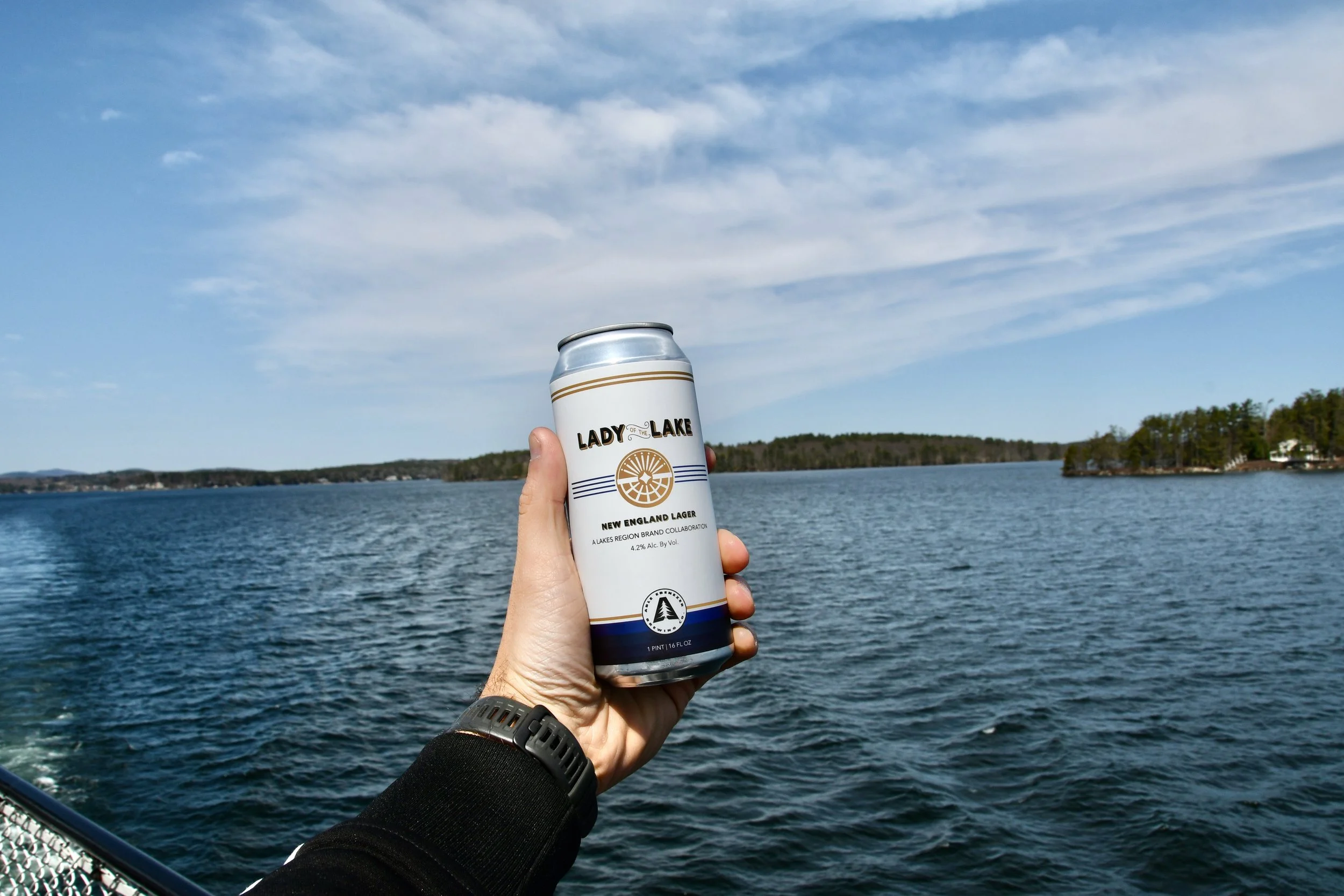“Lady of the Lake” pulling up to her dock at The Weirs, 1870’s.
It was a cool spring morning in 1848 when William Walker, Jr., rode into Lake Village (today, the Lakeport neighborhood of Laconia) to meet with Benjamin J. Cole, one of the lakes region’s community leaders and head of the Cole Manufacturing Company.
He had a bold idea to present: build the largest, fastest steamboat Lake Winnipesaukee - or any other inland waterway - had ever seen, and design her solely for commercial travel.
Walker’s plan was viewed by many as audacious because, to date, very few steamboats had been built primarily for passengers, especially in a region as lightly traveled as New Hampshire’s northern frontier. Lake Winnipesaukee had also not hosted a commercial steamer of consequence for several years. In fact, the remains of the previous one - the Belknap - still clung from the rocks where she wrecked; a reminder that - despite its beauty - Winnipesaukee’s waters could also be treacherous. However, the largest hurdle in his way was this: there really wasn’t any such thing as “tourism” in New Hampshire at the time.
But after hearing William’s plan, Benjamin Cole signed on immediately.
Thus, on June 24, 1848, they incorporated the “Winnipesaukee Steamboat Company” of Lake Village, NH.
-------------
William Walker, Jr., was an ambitious man who led an ambitious life.
Born in 1810, his father was the owner and operator of the Eagle Coffee House, now the famous Eagle Hotel building, directly across from the State House. The Eagle served as a major hub in New Hampshire, with a post office, stables, rooms for travelers and - of course - the coffee shop.
Eagle Coffee House, downtown Concord.
It was here where William began his first work as a coachman and express rider, making regular trips to bring both passengers and parcels beyond Concord to the northern countryside of New Hampshire and Vermont.
In just a few short years, William was able to start his own company: the Walker & Company Express, where he started out with only himself and just one of the Abbot-Downing Company’s soon-to-be-famous “Concord Coaches,” serving the main stage route between Concord and Nashua.
An Abbot-Downing Concord Stagecoach in NH.
His hard work would pay off: just a few years later, he expanded the operation to include multiple carriers and regular routes extending all the way to Canada; the first company to do so. Within a decade, his company had become wildly successful, making him and his partners some of the wealthiest in Concord.
But change was on the horizon.
-------------
In 1835, the first railroad tracks heading north out of Boston were completed, terminating in Lowell.
By 1838, the Nashua & Lowell Railroad extended that line to Nashua’s Main Street, bringing rail travel to the Granite State for the first time.
In 1842, the Concord Railroad continued the line further northward, completing the connection between Boston and New Hampshire’s 3 largest cities: Nashua, Manchester and Concord.
At the same time, there were railroads beginning to build routes out to the Monadnock region, as well as up the seacoast to Exeter, Portsmouth and Maine.
Then, in 1844, the Boston, Concord & Montreal Railroad was formed, with the ambitious goal to bring the rails beyond Concord to the north country of New Hampshire, Vermont and Canada beyond. The first rails heading out of Concord towards Lake Winnipesaukee were laid in 1846.
Boston, Concord & Montreal Railroad Engine #1, named the “Granite State,” shown at The Weirs.
With the emergence of the railroads, William - now experienced in the express business - knew it meant the inevitable decline of the stagecoach express…but in that he also saw an opportunity: far more travelers would be able to enjoy the beauty of his home state by rail rather than by coach.
It was clear to him that a new era in the northern frontier of New Hampshire was about to begin: If steam locomotives were about to conquer the land across NH, bringing people by the thousands to the Granite State, a mighty steam ship would be needed to conquer New Hampshire’s grandest lake.
Soon after, William sold his share in the express to his partners and, on that cool spring day in 1848, he rode out from Concord for the small settlement of Lake Village to meet with one of the region’s pioneering entrepreneurs: Benjamin J. Cole.
Fun fact: the Walker & Company Express would eventually grow to form what ultimately became the famous American Express Company (which, although no longer active in the stage & parcel business, maintains the name to this day).
-------------
Benjamin Cole was born in 1814, the son of an iron smelter in Franconia, and youngest of his 6 siblings. From the time of his birth he was - as the history books put it - “delicate” and often ill (history is unsure of or does not document what affliction he suffered from), which kept him from being able to work as a laborer as he grew older.
So instead, he focused on his education: Benjamin became one of the brightest minds in the region by the time he was in his early twenties. In 1836, he would take over his fathers iron foundry, which had since moved from Franconia to Lake Village, renaming it the “Cole Manufacturing Company.” He then secured a lease on the falls at Lake Village for added mechanical power, allowing him to expand operations to a full cast iron factory, producing everything from stoves, tools, plows and a spread of other complex parts and machinery. Cole Manufacturing quickly became a household name, whose products would be used across the nation in just a few short years.
Yet, despite all the successes, Cole Manufacturing’s biggest challenge in those early years was the lack of logistics support in the Lakes Region: without improved roadways, accessible waterways, or rails, Benjamin had inbound iron ore and outbound finished products transported overland by horse-drawn wagons and coaches; several teams made their way to and from Lake Village weekly bound for the cities to the south.
The Cole Manufacturing Company, late 1800’s.
So Benjamin was elated when the Boston, Concord & Montreal Railroad announced their plans to run track through the Lakes Region: A railroad meant his company no longer needed to rely on the limitations of horses and wagons. Adding to his delight, the railroad had already planned to build their regional station in nearby Meredith Bridge (now downtown Laconia) with maintenance shops and engine house in Lake Village.
His logistics challenges were about to be solved for good.
-------------
As William arrived in Lake Village that spring day in 1848, the Cole Manufacturing Company was in full motion as the running waters from the thaw powered the factory's machinery to full strength. The rails had not yet arrived, but the station was nearing completion.
They didn’t yet know one another well, but William believed Benjamin was the man to partner with if his vision of a steamboat on Lake Winnipesaukee was to be: he had a reputation for imagining things that had not yet been, and the know-how to see them into reality.
William got his meeting, and it was short: Benjamin already saw the potential in the railroad’s expansion to the Lakes Region and beyond. But the idea of a new steamship, capable of reaching every corner of Lake Winnipesaukee could serve as an extension of the railroad and connect every town across the region.
And Benjamin knew the perfect spot to build the pier and station for this new steamboat: along the beaches where Lake Winnipesaukee feeds into Long Bay (today Paugus Bay); at a place the locals called The Weirs.
-------------
The Winnipesaukee Steamboat Company, now composed of a handful of other leaders from the Lakes Region, held its first meeting in September 1848 to finalize their plan.
View of Lake Village in the years after the railroad reached the Lakes Region. “Lady of the Lake” can be seen in the upper left steaming north across Long Bay.
They would build the ship at Lake Village, and partner with the railroad to build a station and dock at The Weirs. From there, the ship would make regular trips across the lake to Center Harbor and Wolfeboro.
William Walker volunteered to take the lead on the ship's overall design, and the board agreed. Although he had very little experience in maritime transport (to his credit he had spent a season working on a small steamboat that ran between Haverhill and Newburyport years before), he was the one with the most experience in logistics and driving, well… anything. Plus, after all, the entire project was his idea to begin with.
Leveraging what we all know today as true “yankee ingenuity,” he went to work immediately, returning to Lake Village just month later with a scale model to present to his partners:
The ship would be 121 feet long, and 25 feet wide at the beam, with the ability to carry 400 passengers. This would give her the largest capacity for a steamboat at that time, surpassing the ocean-going SS Great Britain’s 350 passengers.
The SS Great Britain, 1845.
Lumber for her hull would be cut from oak and pine trees around Lake Winnipesaukee. To power her, she received brand new high-pressure steam boilers and engines, specially built by the Isaac & Seth Adams Company in Boston. This was considered novel for the time, as most steamers had used repurposed low-pressure steam engines from saw mills or old locomotives. So she would not only be one of the largest ships of the day, but one of the fastest as well.
Finally, William wanted to begin construction immediately, and have the new ship launched by summer.
It was a bold design, and would be a massive undertaking to build…but Benjamin believed in going big or going home: although some of their partners were wary of taking on such a large endeavor, he and William convinced them to approve the design as presented.
Thus, construction commenced on the shores of Lake Village in January 1849.
-------------
As the ship began to take shape, the topic of what to call her was raised.
While we’re unsure how the Winnipesaukee Steamboat Company went about deciding who would give her a name, the “History of Wolfeboro NH” does specify who made the final call: A young woman named Hannah Huldah Hoag, the daughter of a preacher in Wolfeboro and close friend of famous poet John Greenleaf Whittier (by all accounts of the time she was a brilliant woman and talented poet herself). She would be the one to ultimately give the new ship its name.
Hannah chose “Lady of the Lake,” after the immortal character Ellen Douglas from the 1810 epic poem by Sir Walter Scott that shares the same name.
Ellen is introduced in Scott’s story on Loch Katrine, rowing her boat with her golden-painted paddle up to the shores where she saves the story’s wounded protagonist. Throughout the story, she embodies beauty and grace, independence, resourcefulness and romance; all aspects William and Benjamin believed their new vessel would represent in this new era on Lake Winnipesaukee.
First edition of Sir Walter Scott’s epic “Lady of the Lake,” 1810.
In the late spring of 1849, after her hull was complete and freshly painted bright white with gold trim, the name “Lady of the Lake” was emblazoned onto her sides.
The final touch was her figurehead: standing 5’ tall it was carved from a single trunk of white pine and painted the same bright white and gold as the “Lady’s” hull, representing the strong and courageous Ellen Douglas - with golden paddle in hand - head raised confidently with her eyes focused on the horizon. Once mounted to her bow, “Lady of the Lake” was complete.
Closeup of the bow of the “Lady,” showing her carved figurehead.
-------------
On May 16, 1849, the “Lady” was launched in front of a crowd of thousands of spectators. A local newspaper published the following account of the event:
“For some time the men worked away at their screws under the bows, while some pulled upon a rope, till at length she started from her resting place and rode like a gallant sea bird, out upon the water. There were about a hundred persons aboard when she left the stocks, among whom were the Lake Village Brass Band, who immediately dedicated her with the tune of ‘A life on the ocean wave, A home on the raging deep.’”
William Walker, the man who first dreamed of this ship and main driver in bringing her to life, was named her first Captain. In the ensuing weeks, he would oversee the testing of her new engines and sea trials out on the waters of Long Bay. She passed with flying colors, and the first tickets were put on sale soon after; they sold out immediately.
On June 13, 1849, the first passengers boarded the “Lady” at Lake Village and, with a sounding of her steam whistle in front of crowds along the shore, she embarked on her maiden voyage for The Weirs, Center Harbor and Wolfeboro.
The new era on Lake Winnipesaukee - one that continues to this day - had officially begun.
-------------
The “Lady of the Lake” was a success from the start.
People from across New England and beyond made the trip to the shores of Lake Winnipesaukee to take in the beauty of the new vessel and surrounding countryside. In fact, so many came to New Hampshire that the railroad took an immediate interest in the “Lady,” since she was driving most of their passenger traffic north.
Advertisement for trips to Wolfeboro, Bear Island & Center Harbor via the “Lady,” under the command of “Captain Walker,” referring to William. This was a promotion to travel to and around Lake Winnipesaukee, and back to Concord, in one day; could literally be the first “day trip” to the lakes, which prior to the railroad and the “Lady” was unheard of.
The Boston, Concord & Montreal Railroad and the Winnipesaukee Steamboat Company started advertising together within the first year of her operation. A year after that, the railroad went ahead and bought the entire company. William Walker and Benjamin Cole remained actively involved in her operation; William would continue on as her Captain for 15 years.
“Lady of the Lake” docked at The Weirs with the original railroad station and Lakeside Avenue in the foreground. For any gen-z readers: you’re seeing double because this was printed for a stereoscope.
In the ensuing years, the success of the “Lady” inspired the construction and operation of several other steamboats on Lake Winnipesaukee, but none could match her speed, capacity or, to be frank, her superior style. As competing vessels came and went over the years, the “Lady” continued her reign over these waters for decades.
That was until 1872.
The Boston & Maine Railroad, which had begun running competing routes to Lake Winnipesaukee and even operated their own steamboats over the years in an attempt to contend with the “Lady,” eventually commissioned the construction of what would become the largest, fastest steamboat in the lake’s history: the “Mount Washington.”
When she was launched from Alton Bay that summer, the “Mount Washington” was over 50 feet longer than the “Lady,” and with a massive high-pressure steam engine putting out over 450 horsepower, she was faster as well.
The original “Mount Washington” pulling up to The Weirs from the same perspective of the “Lady” photo shown at the top of this story. The two photos are taken decades apart.
But this didn’t mark the end of the “Lady,” not by a long shot. The two steamboats worked side by side for many years, blowing their whistles to one another as they passed on their daily routes across the waters of Lake Winnipesaukee.
Decades more would pass before the decision was made to retire the aging “Lady.” Her final passenger voyage was on the evening of September 14, 1893, as she made her last leg from Wolfeboro back to Weirs Beach. On the 19th, one last sentimental cruise was made from The Weirs out to The Broads (the most open part of the lake) where local leaders and crewmates from years past held a celebration of her service.
She was then brought back to Lake Village, where she was first built, to be decommissioned.
-------------
The following year, the “Lady” was towed to a point near Lockes Island where she was ceremoniously “buried” beneath the waters of Lake Winnipesaukee.
She still lives there to this day, her hull in near-perfect condition roughly 40 feet beneath the waves, protected from the elements by the lake she served for so many years.
Her figurehead was removed beforehand, and today is maintained by NH Historical Society, who has it on display at their museum in downtown Concord. She is still painted bright white with gold trim, still firmly gripping her golden paddle, and still looking defiantly toward the horizon.
“Lady of the Lake” figurehead on display at the NH Historical Society in Concord. Reminder: she is 5 feet tall and carved from a single trunk of NH white pine. The sculptor’s name has unfortunately been lost to history. Full details here from the NH Historical Society.
Benjamin continued running the Cole Manufacturing Company, as well as other ventures across the lakes region. He was instrumental in the building of many of the roadways and bridges around Lake Winnipesaukee, and was elected to the NH House of Representatives before eventually serving on the Governor’s Executive Council. He passed in 1899 after a long life serving the Lakes Region.
Benjamin J. Cole and William Walker, Jr.
After retiring from his post as the “Lady’s” Captain, William Walker had built such a reputation that he continued to be called by the title for the remainder of his life, becoming known around the state as “Captain Walker.” He continued to serve on the board of the railroad and steamboat company, opened a merchant business in Concord with his brother Gustavus, and went on to be a founding member of the Concord National Bank.
In 1881, he and his wife celebrated the Golden Anniversary of their marriage in downtown Concord; an event recorded as one of the city’s biggest parties that year. He died one year later on November 22, 1882, and was buried in his family plot at Blossom Hill Cemetery in Concord.
Today, the legacy of the “Lady of the Lake” continues to be carried onward by the “MS Mount Washington,” who now has over 150 years in service. She operates the same routes the “Lady” began in 1849 (and thensome), passing by her resting place every day during the season.
Our many thanks go out to the “Mount” and her crew for allowing us the opportunity to be a part of this wonderful piece of Lake Winnipesaukee’s history. Cheers.

